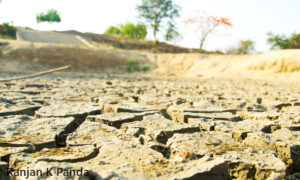Avoidable Deaths: Snakes and Snakebites

The rising number of deaths due to snakebites must serve as a wakeup call for the public authorities to strengthen the capacity of the public hospitals to respond and save the lives of the people.
Sudden death or end of life triggers strange emotions like frightening, startling and creepy feelings among the remaining family members, and especially when the reason of death is preceded by an avoidable event like snake bite. It generates annoyance, resentment and bitterness.
In India, this sole reason takes away on an average 64,000 lives annually, making the country capital of snake bite hazards. As per World Health Organization, around 5.4million people across the globe get bitten by the snakes out of which 2.7million gets envenomed due to snake bite leading to amputations of body parts and settling down with permanent disability or receive fatal deaths.
Multiple impact of venomous snake bite may vary from paralytic attack due to neurotoxin snake venom affecting neuromuscular junction leading to disruption in neurotransmission, irreversible kidney failure, tissue damage or bleeding disorder leading to fatal hemorrhage.
The serpents, a family of reptiles are present in every part of the world except polar region and especially in New Zealand, Iceland and Ireland.
The cold blooded, soft body, legless creature covered under scale that gets shaded in a regular interval have spectacular beguiling locomotion that help them to navigate most part of the earth.
The change in the surface changes the muscle activity, lateral bending along with the length of snakes that allows the reptile to trade on narrow surface even with discrete point, they use their entire body to support the movement.
Flexibility of their body help them to attain locomotion like bridging gap, concertina, side winding, lateral undulation and rectilinear locomotion that any other terrestrial animal can ever think off. This agile and pliable body structure of the snake that can accommodate on every surface often remains discrete and unobtrusive from vision making them vulnerable to be stepped on by other animals.
The immediate result is foray with barge, biting the culprit who had given them the physical pain. Majority of the snake victims in India get the reptile bites while doing manual labour in their agricultural land and also the children playing outdoor games.
India, a land of diverse geographical features, housed around 300 types of snakes of which nearly 180 types are non-venomous, more than 40 varieties are mildly venomous and 60 varieties possessing fatal venom in their teeth.
According to an article, “Clinical and epidemiological profile of snakebite cases – A study from an industrial teaching hospital at Jamshedpur, Jharkhand, India”, which was conducted over a period of seven years(2014-21) from the snake bite victims admitted in a particular hospital in Jamshedpur states that 69% of the snake bite victims were male.
With regard to the age group, majority of victims nearly 75%, belong to the productive age group of 18-45 years of age. Further dissecting the percentage of victims between urban and rural, it is the rural population who are more vulnerable to the snake attack constituting nearly 68% of the total victims. Out of total sample of 427 cases of registered snake bite cases in the studied hospital, based on the clinical features, sign and symptoms 38.64% of the victims were treated with anti snake venom and the remaining were managed on supportive and conservative therapy, a major problem prevailing in all over the country.
Majority of Indian youths especially belonging to rural areas, in their productive age group are vulnerable to snake bites followed by higher percentage of morbidity and mortality, came to light after the publication of first ever nationally representation “Million Death Study” report in the year 2011.
The study confirmed that the snake bite is becoming a serious problem of the country generating 50,000 deaths from one million snake bites. The sequel of that report published in the year 2020, presented another horrifying reality that Indians within a range of 1.1-1.7millions are bleeding annually with snake bites out of which 58,000 individuals are succumbing to death.
Figuratively it can be said that every hour, around seven Indians are dying due to snake bite, which is a curable incident. Another agonizing fact revealed by this study is that more than 90% snake bites are happening in rural areas and the victims are primarily belonging to the productive age group.
WHO included snake bite in its list of neglected tropical disease in the year 2009, with the affirmation that it is the occupational hazard involved in the primary sector leading to deaths of tens of thousands each year and many more individuals developing permanent disabilities. Snakes, the meat eaters, belong to the middle order food chain category, act as a predator and prey as well, have an incredible secretive survival strategy.
In this regard recognizing and grasping the behavioural pattern of snakes may act as a precautionary measure to avoid snake bite. Geographical variation act as a determining factor in the prevalence of varieties of snakes in the region along with their variation in traits. Spreading awareness about local snakes and precautionary measures to respond to snake bite helps to a great extent in reducing morbidity and mortality.
In case of venomous snake bites, administration of high quality antivenom with proper protocol is the only effective method to prevent and reverse the effect of venom.
Mortality, morbidity of youths and young ones, a disaster for the family and the economy as well, followed by venomous snake bite belongs to avoidable death category.
WHO included availability of antivenom in the list of essential medicines, which needs to be part of any primary health care center specifically belonging to rural areas infested by the presence of snakes.
Few precautionary measures, spread of awareness, availability of antivenom in the primary health care center along with deployment of snake bite specialist can save many lives and families from sufferings.
The rising number of deaths due to snakebites must serve as a wakeup call for the public authorities to strengthen the capacity of the public hospitals to respond and save the lives of the people.
These deaths can be avoided and must be avoided.












































